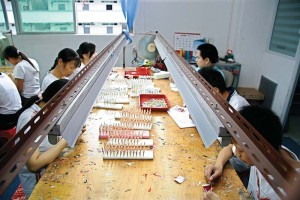Foreign appeal

China’s economic policies took a new turn about 30 years ago when it established a Special Economic Zone (SEZ) in Shenzhen. The government’s plan was to create a free market society by legalizing the development of private enterprises with the primary purpose of exporting goods abroad.
At that time, there was an excessive labour force willing to work for low wages. Foreign companies, especially those in Europe and North America, saw it as an opportunity to decrease their manufacturing and labour costs. This was especially beneficial to the jewellery industry, which is labour-intensive.
Chinese entrepreneurs began to open jewellery factories to cater to foreign markets. Growing orders and investments from overseas resulted in a boom in China’s jewellery manufacturing industry. By 2000, numerous foreign jewellery companies had closed their manufacturing facilities at home and shifted their operations to China.
Money started to flow to factory owners, while workers, seeing the new wealth, began demanding better working conditions and wages. The government introduced labour reforms as a way to redistribute the wealth and to ensure workers’ rights. This resulted in higher pay and less working hours. In addition, inflation was on the rise, rents were going up, and the cost of raw materials was increasing, all while China’s currency was quickly appreciating.
As a result, profits among jewellery manufacturers began to erode, although many factories were still able to survive due to the large volume of orders. However, in 2008, the global financial crisis hit, impacting not only luxury jewellery sales, but manufacturing. Factory orders diminished and remaining profits slowly evaporated.
Soon enough, owners cut costs by laying off workers and downsizing their factories, although some opted to move farther inland, where labour and rent were less than half the price of coastal regions. Some factories turned to part-time labour or even outsourced production into people’s homes. Others, however, could not handle the market downturn and cut their losses by simply closing their doors. I have seen one factory converted into a hotel and another into a supermarket.
Our silver jewellery factory was no exception. We saw steady growth in the business for the first few years and then the volume of orders began declining, forcing us to reduce the size of our operation by one third and laying off some staff. This year, we are moving our factory to Sihui, a smaller city a few hours north of Shenzhen. There, rent and labour costs will be cut in half.
During the global recession, China was experiencing rapid economic growth in other areas of its economy, due to its foreign direct investment (FDI) initiative. This created more highly skilled jobs and linked the Chinese economy to international markets. Low-wage labourers evolved into middle class, with a growing appetite for foreign goods and increased spending power.





